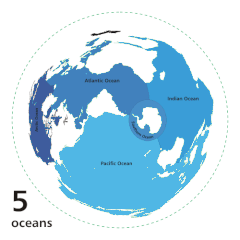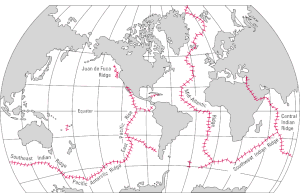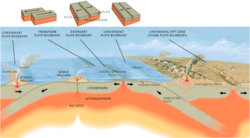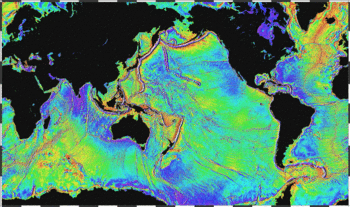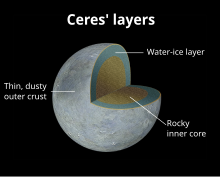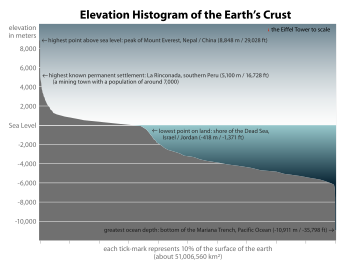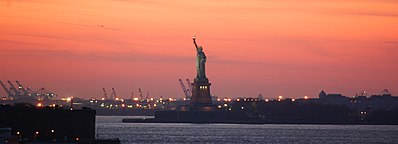Clouds over the Atlantic Ocean
An ocean is a body of water that composes much of a planet's hydrosphere. On Earth, an ocean is one of the major conventional divisions of the World Ocean. These are, in descending order by area, the Pacific, Atlantic, Indian, Southern (Antarctic), and Arctic Oceans. The word "ocean" is often used interchangeably with "sea" in American English. Strictly speaking, a sea is a body of water (generally a division of the world ocean) partly or fully enclosed by land, though "the sea" refers also to the oceans.
Saline water covers approximately 361,000,000 km2
(139,000,000 sq mi) and is customarily divided into several principal
oceans and smaller seas, with the ocean covering approximately 71% of
Earth's surface and 90% of the Earth's biosphere. The ocean contains 97% of Earth's water, and oceanographers have stated that less than 5% of the World Ocean has been explored.
The total volume is approximately 1.35 billion cubic kilometers (320
million cu mi) with an average depth of nearly 3,700 meters (12,100 ft).
As the world ocean is the principal component of Earth's hydrosphere, it is integral to life, forms part of the carbon cycle, and influences climate and weather patterns. The World Ocean is the habitat of 230,000 known species, but because much of it is unexplored, the number of species that exist in the ocean is much larger, possibly over two million. The origin of Earth's oceans is unknown; oceans are thought to have formed in the Hadean eon and may have been the impetus for the emergence of life.
Extraterrestrial oceans may be composed of water or other elements and compounds. The only confirmed large stable bodies of extraterrestrial surface liquids are the lakes of Titan, although there is evidence for the existence of oceans elsewhere in the Solar System. Early in their geologic histories, Mars and Venus are theorized to have had large water oceans. The Mars ocean hypothesis suggests that nearly a third of the surface of Mars was once covered by water, and a runaway greenhouse effect may have boiled away the global ocean of Venus. Compounds such as salts and ammonia
dissolved in water lower its freezing point so that water might exist
in large quantities in extraterrestrial environments as brine or
convecting ice. Unconfirmed oceans are speculated beneath the surface of many dwarf planets and natural satellites; notably, the ocean of Europa is estimated to have over twice the water volume of Earth. The Solar System's giant planets are also thought to have liquid atmospheric layers of yet to be confirmed compositions. Oceans may also exist on exoplanets and exomoons, including surface oceans of liquid water within a circumstellar habitable zone. Ocean planets are a hypothetical type of planet with a surface completely covered with liquid.
Etymology
The word ocean comes from the figure in classical antiquity, Oceanus (/oʊˈsiːənəs/; Greek: Ὠκεανός Ōkeanós, pronounced [ɔːkeanós]), the elder of the Titans in classical Greek mythology, believed by the ancient Greeks and Romans to be the divine personification of the sea, an enormous river encircling the world.
The concept of Ōkeanós has an Indo-European connection. Greek Ōkeanós has been compared to the Vedic
epithet ā-śáyāna-, predicated of the dragon Vṛtra-, who captured the
cows/rivers. Related to this notion, the Okeanos is represented with a
dragon-tail on some early Greek vases.
Earth's global ocean
Various ways to divide the World Ocean
Oceanic divisions
1.
Epipelagic zone: surface – 200 meters deep 2. Mesopelagic zone: 200 m –
1000 m 3. Bathypelagic zone: 1000 m – 4000 m 4. Abyssopelagic zone:
4000 m – 6000 m 5. Hadal zone (the trenches): 6000 m to the bottom of
the ocean
Though generally described as several separate oceans, the global,
interconnected body of salt water is sometimes referred to as the World Ocean or global ocean. The concept of a continuous body of water with relatively free interchange among its parts is of fundamental importance to oceanography.
The major oceanic divisions – listed below in descending order of area and volume – are defined in part by the continents, various archipelagos, and other criteria.
| # | Ocean | Location | Area (km2) (%) |
Volume (km3) (%) |
Avg. depth (m) |
Coastline (km) |
|---|---|---|---|---|---|---|
| 1 | Pacific Ocean | Separates Asia and Oceania from the Americas | 168,723,000 46.6 |
669,880,000 50.1 |
3,970 | 135,663 |
| 2 | Atlantic Ocean | Separates the Americas from Europe and Africa | 85,133,000 23.5 |
310,410,900 23.3 |
3,646 | 111,866 |
| 3 | Indian Ocean | Washes upon southern Asia and separates Africa and Australia | 70,560,000 19.5 |
264,000,000 19.8 |
3,741 | 66,526 |
| 4 | Southern Ocean | Sometimes considered an extension of the Pacific, Atlantic and Indian Oceans, which encircles Antarctica | 21,960,000 6.1 |
71,800,000 5.4 |
3,270 | 17,968 |
| 5 | Arctic Ocean | Sometimes considered a sea or estuary of the Atlantic, which covers much of the Arctic and washes upon northern North America and Eurasia | 15,558,000 4.3 |
18,750,000 1.4 |
1,205 | 45,389 |
| Total – World Ocean | 361,900,000 100 |
1.335×109 100 |
3,688 | 377,412 | ||
| Sea | Location | Area
(sq. km)
|
# |
|---|---|---|---|
| Arabian Sea | Between the Arabian peninsula and the Indian subcontinent | 3,862,000 | 1 |
| Bay of Bengal | Between the Indian subcontinent and the malaysia peninsula | 2,173,000 | 2 |
NB: Volume, area, and average depth figures include NOAA ETOPO1 figures for marginal South China Sea.
Sources: Encyclopedia of Earth, International Hydrographic Organization, Regional Oceanography: an Introduction (Tomczak, 2005), Encyclopædia Britannica, and the International Telecommunication Union.
Sources: Encyclopedia of Earth, International Hydrographic Organization, Regional Oceanography: an Introduction (Tomczak, 2005), Encyclopædia Britannica, and the International Telecommunication Union.
Oceans are fringed by smaller, adjoining bodies of water such as seas, gulfs, bays, bights, and straits.
Global system
World Distribution of Mid-Oceanic Ridges; USGS
Three main types of plate boundaries.
The mid-ocean ridges of the world are connected and form a single global mid-oceanic ridge system that is part of every ocean and the longest mountain range in the world. The continuous mountain range is 65,000 km (40,000 mi) long (several times longer than the Andes, the longest continental mountain range).
Physical properties
The total mass of the hydrosphere is about 1.4 quintillion metric tons (1.4×1018 long tons or 1.5×1018 short tons), which is about 0.023% of Earth's total mass. Less than 3% is freshwater; the rest is saltwater,
almost all of which is in the ocean. The area of the World Ocean is
about 361.9 million square kilometers (139.7 million square miles),
which covers about 70.9% of Earth's surface, and its volume is
approximately 1.335 billion cubic kilometers (320.3 million cubic
miles).
This can be thought of as a cube of water with an edge length of 1,101
kilometers (684 mi). Its average depth is about 3,688 meters
(12,100 ft), and its maximum depth is 10,994 meters (6.831 mi) at the Mariana Trench. Nearly half of the world's marine waters are over 3,000 meters (9,800 ft) deep. The vast expanses of deep ocean (anything below 200 meters or 660 feet) cover about 66% of Earth's surface. This does not include seas not connected to the World Ocean, such as the Caspian Sea.
The bluish ocean color is a composite of several contributing agents. Prominent contributors include dissolved organic matter and chlorophyll. Mariners and other seafarers have reported that the ocean often emits a visible glow
which extends for miles at night. In 2005, scientists announced that
for the first time, they had obtained photographic evidence of this
glow. It is most likely caused by bioluminescence.
Oceanic zones
The major oceanic zones, based on depth and biophysical conditions
Oceanographers divide the ocean into different vertical zones defined by physical and biological conditions. The pelagic zone includes all open ocean regions, and can be divided into further regions categorized by depth and light abundance. The photic zone
includes the oceans from the surface to a depth of 200 m; it is the
region where photosynthesis can occur and is, therefore, the most biodiverse. Because plants require photosynthesis, life found deeper than the photic zone must either rely on material sinking from above (see marine snow) or find another energy source. Hydrothermal vents are the primary source of energy in what is known as the aphotic zone (depths exceeding 200 m). The pelagic part of the photic zone is known as the epipelagic.
The pelagic part of the aphotic zone can be further divided into vertical regions according to temperature.
The mesopelagic is the uppermost region. Its lowermost boundary is at a thermocline of 12 °C (54 °F), which, in the tropics generally lies at 700–1,000 meters (2,300–3,300 ft). Next is the bathypelagic
lying between 10 and 4 °C (50 and 39 °F), typically between 700–1,000
meters (2,300–3,300 ft) and 2,000–4,000 meters (6,600–13,100 ft), lying
along the top of the abyssal plain is the abyssopelagic, whose lower boundary lies at about 6,000 meters (20,000 ft). The last zone includes the deep oceanic trench, and is known as the hadalpelagic. This lies between 6,000–11,000 meters (20,000–36,000 ft) and is the deepest oceanic zone.
The benthic zones are aphotic and correspond to the three deepest zones of the deep-sea. The bathyal zone
covers the continental slope down to about 4,000 meters (13,000 ft).
The abyssal zone covers the abyssal plains between 4,000 and 6,000 m.
Lastly, the hadal zone corresponds to the hadalpelagic zone, which is found in oceanic trenches.
The pelagic zone can be further subdivided into two subregions: the neritic zone and the oceanic zone. The neritic zone encompasses the water mass directly above the continental shelves whereas the oceanic zone includes all the completely open water.
In contrast, the littoral zone
covers the region between low and high tide and represents the
transitional area between marine and terrestrial conditions. It is also
known as the intertidal zone because it is the area where tide level affects the conditions of the region.
If a zone undergoes dramatic changes in temperature with depth, it contains a thermocline.
The tropical thermocline is typically deeper than the thermocline at
higher latitudes. Polar waters, which receive relatively little solar
energy, are not stratified by temperature and generally lack a
thermocline because surface water at polar latitudes are nearly as cold
as water at greater depths. Below the thermocline, water is very cold,
ranging from −1 °C to 3 °C. Because this deep and cold layer contains
the bulk of ocean water, the average temperature of the world ocean is
3.9 °C.[citation needed]
If a zone undergoes dramatic changes in salinity with depth, it contains a halocline. If a zone undergoes a strong, vertical chemistry gradient with depth, it contains a chemocline.
The halocline often coincides with the thermocline, and the combination produces a pronounced pycnocline.
Exploration
Map of large underwater features (1995, NOAA)
The deepest point in the ocean is the Mariana Trench, located in the Pacific Ocean near the Northern Mariana Islands. Its maximum depth has been estimated to be 10,971 meters (35,994 ft) (plus or minus 11 meters; see the Mariana Trench article for discussion of the various estimates of the maximum depth.) The British naval vessel Challenger II surveyed the trench in 1951 and named the deepest part of the trench the "Challenger Deep". In 1960, the Trieste successfully reached the bottom of the trench, manned by a crew of two men.
Oceanic maritime currents
Oceanic surface currents (U.S. Army, 1943).
Amphidromic points showing the direction of tides per incrementation periods along with resonating directions of wavelength movements.
Oceanic maritime currents have different origins. Tidal currents are in phase with the tide, hence are quasiperiodic; they may form various knots in certain places, most notably around headlands. Non-periodic currents have for origin the waves, wind and different densities.
The wind and waves
create surface currents (designated as “drift currents”). These
currents can decompose in one quasi-permanent current (which varies
within the hourly scale) and one movement of Stokes drift under the effect of rapid waves movement (at the echelon of a couple of seconds).).[36]
The quasi-permanent current is accelerated by the breaking of waves,
and in a lesser governing effect, by the friction of the wind on the
surface.
This acceleration of the current takes place in the direction of
waves and dominant wind. Accordingly, when the sea depth increases, the rotation of the earth
changes the direction of currents in proportion with the increase of
depth, while friction lowers their speed. At a certain sea depth, the
current changes direction and is seen inverted in the opposite direction
with current speed becoming null: known as the Ekman spiral.
The influence of these currents is mainly experienced at the mixed
layer of the ocean surface, often from 400 to 800 meters of maximum
depth. These currents can considerably alter, change and are dependent
on the various yearly seasons. If the mixed layer is less thick (10 to
20 meters), the quasi-permanent current at the surface adopts an extreme
oblique direction in relation to the direction of the wind, becoming
virtually homogeneous, until the Thermocline.
In the deep however, maritime currents are caused by the temperature gradients and the salinity between water density masses.
In littoral zones, breaking waves are so intense and the depth measurement so low, that maritime currents reach often 1 to 2 knots.
Climate
A map of the global thermohaline circulation; blue represent deep-water currents, whereas red represent surface currents
Ocean currents greatly affect Earth's climate by transferring heat from the tropics to the polar regions. Transferring warm or cold air and precipitation to coastal regions, winds may carry them inland. Surface heat and freshwater fluxes create global density gradients that drive the thermohaline circulation
part of large-scale ocean circulation. It plays an important role in
supplying heat to the polar regions, and thus in sea ice regulation.
Changes in the thermohaline circulation are thought to have significant
impacts on Earth's energy budget.
In so far as the thermohaline circulation governs the rate at which
deep waters reach the surface, it may also significantly influence
atmospheric carbon dioxide concentrations.
The Antarctic Circumpolar Current encircles that continent, influencing the area's climate and connecting currents in several oceans.
One of the most dramatic forms of weather occurs over the oceans: tropical cyclones (also called "typhoons" and "hurricanes" depending upon where the system forms).
Biology
The ocean has a significant effect on the biosphere. Oceanic evaporation, as a phase of the water cycle, is the source of most rainfall, and ocean temperatures determine climate and wind patterns that affect life on land. Life within the ocean evolved 3 billion years prior to life on land. Both the depth and the distance from shore strongly influence the biodiversity of the plants and animals present in each region.
As it is thought that life evolved in the ocean, the diversity of life is immense, including:
- Bacteria : ubiquitous single-celled prokaryotes found throughout the world
- Archaea : prokaryotes distinct from bacteria, that inhabit many environments of the ocean, as well as many extreme environments
- Algae : algae is a "catch-all" term to include many photosynthetic, single-celled eukaryotes, such as green algae, diatoms, and dinoflagellates, but also multicellular algae, such as some red algae (including organisms like Pyropia, which is the source of the edible nori seaweed), and brown algae (including organisms like kelp).
- Plants : including sea grasses, or mangroves
- Fungi : many marine fungi with diverse roles are found in oceanic environments
- Animals : most animal phyla have species that inhabit the ocean, including many that are only found in marine environments such as sponges, Cnidaria (such as corals and jellyfish), comb jellies, Brachiopods, and Echinoderms (such as sea urchins and sea stars). Many other familiar animal groups primarily live in the ocean, including cephalopods (includes octopus and squid), crustaceans (includes lobsters, crabs, and shrimp), fish, sharks, cetaceans (includes whales, dolphins, and porpoises).
In addition, many land animals have adapted to living a major part of their life on the oceans. For instance, seabirds
are a diverse group of birds that have adapted to a life mainly on the
oceans. They feed on marine animals and spend most of their lifetime on
water, many only going on land for breeding. Other birds that have
adapted to oceans as their living space are penguins, seagulls and pelicans. Seven species of turtles, the sea turtles, also spend most of their time in the oceans.
Gases
| Gas | Concentration of seawater, by mass (in parts per million), for the whole ocean | % Dissolved gas, by volume, in seawater at the ocean surface |
|---|---|---|
| Carbon dioxide (CO2) | 64 to 107 | 15% |
| Nitrogen (N2) | 10 to 18 | 48% |
| Oxygen (O2) | 0 to 13 | 36% |
| Temperature | O2 | CO2 | N2 |
|---|---|---|---|
| 0 °C | 8.14 | 8,700 | 14.47 |
| 10 °C | 6.42 | 8,030 | 11.59 |
| 20 °C | 5.26 | 7,350 | 9.65 |
| 30 °C | 4.41 | 6,600 | 8.26 |
Surface
| Characteristic | Oceanic waters in polar regions | Oceanic waters in temperate regions | Oceanic waters in tropical regions |
|---|---|---|---|
| Precipitation vs. evaporation | P > E | P > E | E > P |
| Sea surface temperature in winter | −2 °C | 5 to 20 °C | 20 to 25 °C |
| Average salinity | 28‰ to 32‰ | 35‰ | 35‰ to 37‰ |
| Annual variation of air temperature | ≤ 40ªC | 10 °C | < 5 °C |
| Annual variation of water temperature | < 5ªC | 10 °C | < 5 °C |
Mixing time
| Constituent | Residence time (in years) |
|---|---|
| Iron (Fe) | 200 |
| Aluminum (Al) | 600 |
| Manganese (Mn) | 1,300 |
| Water (H2O) | 4,100 |
| Silicon (Si) | 20,000 |
| Carbonate (CO32−) | 110,000 |
| Calcium (Ca2+) | 1,000,000 |
| Sulfate (SO42−) | 11,000,000 |
| Potassium (K+) | 12,000,000 |
| Magnesium (Mg2+) | 13,000,000 |
| Sodium (Na+) | 68,000,000 |
| Chloride (Cl−) | 100,000,000 |
Salinity
A zone of rapid salinity increase with depth is called a halocline. The temperature of maximum density of seawater
decreases as its salt content increases. Freezing temperature of water
decreases with salinity, and boiling temperature of water increases with
salinity. Typical seawater freezes at around −2 °C at atmospheric pressure.
If precipitation exceeds evaporation, as is the case in polar and
temperate regions, salinity will be lower. If evaporation exceeds
precipitation, as is the case in tropical regions, salinity will be
higher. Thus, oceanic waters in polar regions have lower salinity
content than oceanic waters in temperate and tropical regions.
Salinity can be calculated using the chlorinity, which is a
measure of the total mass of halogen ions (includes fluorine, chlorine,
bromine, and iodine) in seawater. By international agreement, the
following formula is used to determine salinity:
Salinity (in ‰) = 1.80655 × Chlorinity (in ‰)
The average chlorinity is about 19.2‰, and, thus, the average salinity is around 34.7‰
Absorption of light
| Color: Wavelength (nm) | Depth at which 99 percent of the wavelength is absorbed (in meters) | Percent absorbed in 1 meter of water |
|---|---|---|
| Ultraviolet (UV): 310 | 31 | 14.0 |
| Violet (V): 400 | 107 | 4.2 |
| Blue (B): 475 | 254 | 1.8 |
| Green (G): 525 | 113 | 4.0 |
| Yellow (Y): 575 | 51 | 8.7 |
| Orange (O): 600 | 25 | 16.7 |
| Red (R): 725 | 4 | 71.0 |
| Infrared (IR): 800 | 3 | 82.0 |
Economic value
Many of the world's goods are moved by ship between the world's seaports. Oceans are also the major supply source for the fishing industry. Some of the major harvests are shrimp, fish, crabs, and lobster.
Waves and swell
The motions of the ocean surface, known as undulations or waves, are the partial and alternate rising and falling of the ocean surface. The series of mechanical waves that propagate along the interface between water and air is called swell.
Extraterrestrial oceans
Artist's conception of subsurface ocean of Enceladus confirmed April 3, 2014.
Two
models for the composition of Europa predict a large subsurface ocean
of liquid water. Similar models have been proposed for other celestial
bodies in the Solar System.
Although Earth is the only known planet with large stable bodies of liquid water on its surface and the only one in the Solar System, other celestial bodies are thought to have large oceans.
Planets
The gas giants, Jupiter and Saturn, are thought to lack surfaces and instead have a stratum of liquid hydrogen; however their planetary geology is not well understood. The possibility of the ice giants Uranus and Neptune having hot, highly compressed, supercritical
water under their thick atmospheres has been hypothesised. Although
their composition is still not fully understood, a 2006 study by
Wiktorowicz and Ingersall ruled out the possibility of such a water
"ocean" existing on Neptune, though some studies have suggested that exotic oceans of liquid diamond are possible.
The Mars ocean hypothesis
suggests that nearly a third of the surface of Mars was once covered by
water, though the water on Mars is no longer oceanic (much of it
residing in the ice caps). The possibility continues to be studied along with reasons for their apparent disappearance. Astronomers think that Venus had liquid water and perhaps oceans in its very early history. If they existed, all later vanished via resurfacing.
Natural satellites
A global layer of liquid water thick enough to decouple the crust from the mantle is thought to be present on the natural satellites Titan, Europa, Enceladus and, with less certainty, Callisto, Ganymede and Triton. A magma ocean is thought to be present on Io. Geysers have been found on Saturn's moon Enceladus, possibly originating from an ocean about 10 kilometers (6.2 mi) beneath the surface ice shell. Other icy moons may also have internal oceans, or may once have had internal oceans that have now frozen.
Large bodies of liquid hydrocarbons are thought to be present on the surface of Titan, although they are not large enough to be considered oceans and are sometimes referred to as lakes or seas. The Cassini–Huygens
space mission initially discovered only what appeared to be dry
lakebeds and empty river channels, suggesting that Titan had lost what
surface liquids it might have had. Later flybys of Titan provided radar
and infrared images that showed a series of hydrocarbon lakes in the
colder polar regions. Titan is thought to have a subsurface liquid-water
ocean under the ice in addition to the hydrocarbon mix that forms atop
its outer crust.
Dwarf planets and trans-Neptunian objects
Diagram showing a possible internal structure of Ceres
Ceres appears to be differentiated into a rocky core and icy mantle and may harbour a liquid-water ocean under its surface.
Not enough is known of the larger trans-Neptunian objects
to determine whether they are differentiated bodies capable of
supporting oceans, although models of radioactive decay suggest that Pluto, Eris, Sedna, and Orcus have oceans beneath solid icy crusts approximately 100 to 180 km thick.
Extrasolar
Rendering of a hypothetical large extrasolar moon with surface liquid-water oceans
Some planets and natural satellites outside the Solar System are
likely to have oceans, including possible water ocean planets similar to
Earth in the habitable zone or "liquid-water belt". The detection of oceans, even through the spectroscopy method, however is likely extremely difficult and inconclusive.
Theoretical models have been used to predict with high probability that GJ 1214 b, detected by transit, is composed of exotic form of ice VII, making up 75% of its mass,
making it an ocean planet.
Other possible candidates are merely speculated based on their
mass and position in the habitable zone include planet though little is
actually known of their composition. Some scientists speculate Kepler-22b may be an "ocean-like" planet. Models have been proposed for Gliese 581 d that could include surface oceans. Gliese 436 b is speculated to have an ocean of "hot ice". Exomoons orbiting planets, particularly gas giants within their parent star's habitable zone may theoretically have surface oceans.
Terrestrial planets will acquire water during their accretion,
some of which will be buried in the magma ocean but most of it will go
into a steam atmosphere, and when the atmosphere cools it will collapse
on to the surface forming an ocean. There will also be outgassing of
water from the mantle as the magma solidifies—this will happen even for
planets with a low percentage of their mass composed of water, so
"super-Earth exoplanets may be expected to commonly produce water oceans
within tens to hundreds of millions of years of their last major
accretionary impact."
Non-water surface liquids
Oceans, seas, lakes and other bodies of liquids can be composed of liquids other than water, for example the hydrocarbon lakes on Titan. The possibility of seas of nitrogen on Triton was also considered but ruled out. There is evidence that the icy surfaces of the moons Ganymede, Callisto, Europa, Titan and Enceladus are shells floating on oceans of very dense liquid water or water–ammonia. Earth is often called the ocean planet because it is 70% covered in water. Extrasolar terrestrial planets that are extremely close to their parent star will be tidally locked and so one half of the planet will be a magma ocean.
It is also possible that terrestrial planets had magma oceans at some
point during their formation as a result of giant impacts. Hot Neptunes close to their star could lose their atmospheres via hydrodynamic escape, leaving behind their cores with various liquids on the surface.
Where there are suitable temperatures and pressures, volatile chemicals
that might exist as liquids in abundant quantities on planets include ammonia, argon, carbon disulfide, ethane, hydrazine, hydrogen, hydrogen cyanide, hydrogen sulfide, methane, neon, nitrogen, nitric oxide, phosphine, silane, sulfuric acid, and water.
Supercritical fluids, although not liquids, do share various
properties with liquids. Underneath the thick atmospheres of the planets
Uranus and Neptune,
it is expected that these planets are composed of oceans of hot
high-density fluid mixtures of water, ammonia and other volatiles. The gaseous outer layers of Jupiter and Saturn transition smoothly into oceans of supercritical hydrogen. The atmosphere of Venus is 96.5% carbon dioxide, which is a supercritical fluid at its surface.

